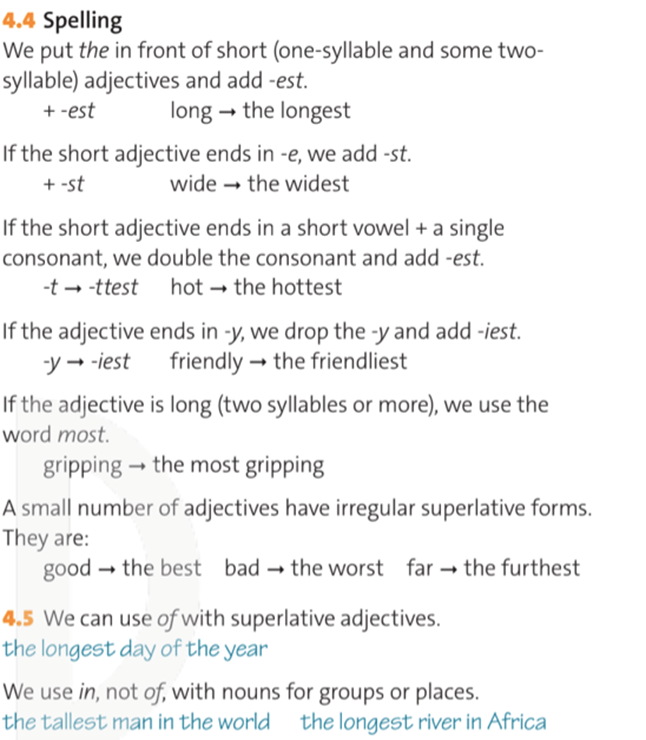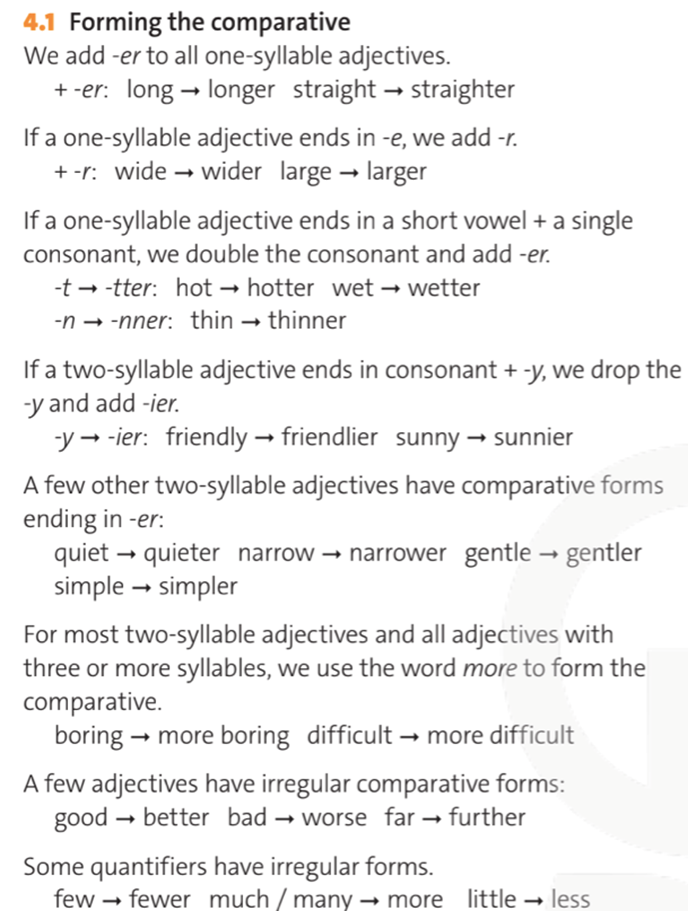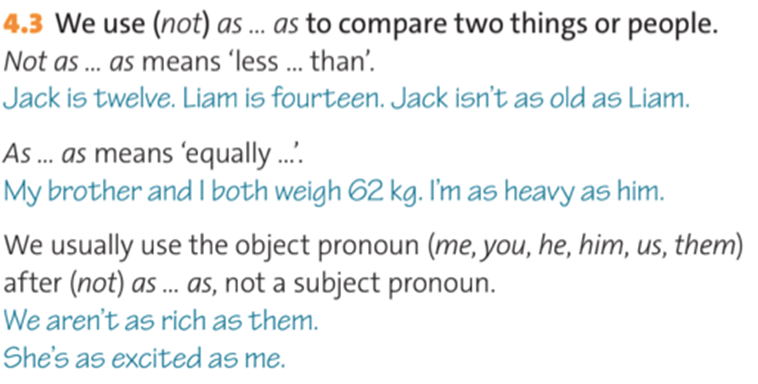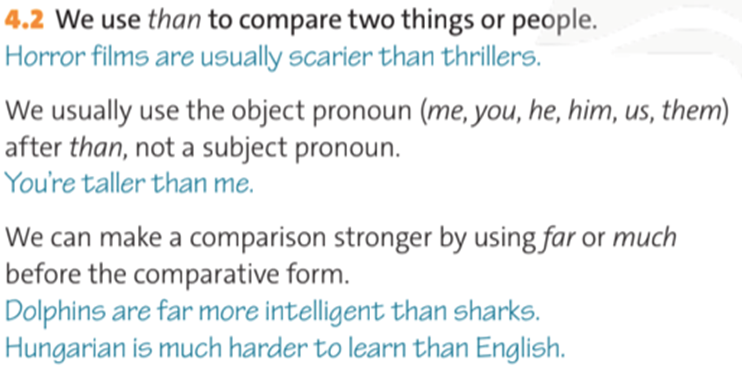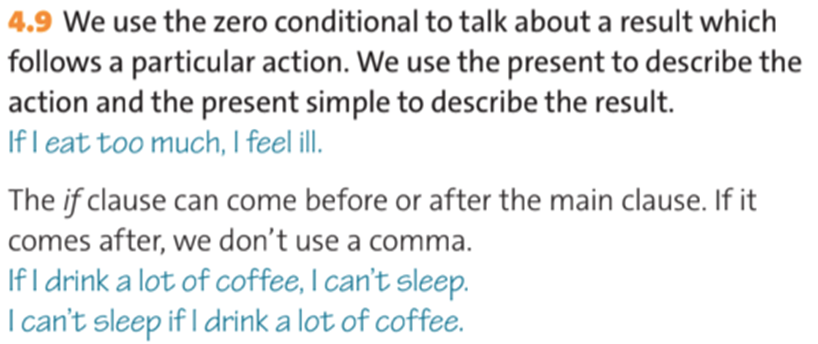Câu hỏi trong đề: Bài tập Grammar Reference có đáp án !!
Quảng cáo
Trả lời:
Hướng dẫn dịch:
Chính tả
- Chúng tôi đặt trước tính từ ngắn (có một hoặc hai âm tiết) đuôi -est.
dài -> dài nhất
- Nếu tính từ ngắn kết thúc bằng -e, ta thêm -st.
rộng-> rộng nhất
- Nếu tính từ ngắn kết thúc bằng một nguyên âm ngắn + một phụ âm đơn, ta nhân đôi phụ âm rồi thêm-est.
nóng -> nóng nhất
Nếu tính từ kết thúc bằng -y, chúng ta bỏ -y và thêm -iest.
thân thiện -> thân thiệt nhất
- Nếu tính từ dài (hai âm tiết trở lên), chúng ta sử dụng từ most.
hấp dẫn -> hấp dẫn nhất
- Một số ít các tính từ có dạng so sánh nhất bất quy tắc. Đó là:
tốt -> tốt nhất
xấu -> xấu nhất
xa -> xa nhất
Hot: 1000+ Đề thi cuối kì 1 file word cấu trúc mới 2025 Toán, Văn, Anh... lớp 1-12 (chỉ từ 60k). Tải ngay
- Trọng tâm Lí, Hóa, Sinh 10 cho cả 3 bộ KNTT, CTST và CD VietJack - Sách 2025 ( 40.000₫ )
- Trọng tâm Toán, Văn, Anh 10 cho cả 3 bộ KNTT, CTST, CD VietJack - Sách 2025 ( 13.600₫ )
- Sách lớp 10 - Combo Trọng tâm Toán, Văn, Anh và Lí, Hóa, Sinh cho cả 3 bộ KNTT, CD, CTST VietJack ( 75.000₫ )
- Sách lớp 11 - Trọng tâm Toán, Lý, Hóa, Sử, Địa lớp 11 3 bộ sách KNTT, CTST, CD VietJack ( 52.000₫ )
CÂU HỎI HOT CÙNG CHỦ ĐỀ
Lời giải
Hướng dẫn dịch:
Thành lập tính từ so sánh:
- Ta thêm -er vào các tính từ có một âm tiết.
dài -> dài hơn
thẳng -> thẳng hơn
- Nếu tính từ một âm tiết kết thúc bằng -e, ta thêm-r.
rộng -> rộng hơn
lớn -> lớn hơn
- Nếu tính từ một âm tiết kết thúc bằng một nguyên âm ngắn + một phụ âm đơn, chúng ta nhân đôi phụ âm và thêm -er.
nóng -> nóng hơn
ướt -> ướt hơn
mỏng -> mỏng hơn
- Nếu một tính từ hai âm tiết kết thúc bằng phụ âm + -y, ta bỏ -y và thêm-ier.
thân thiện -> thân thiện hơn
nắng -> nắng hơn
- Một vài tính từ hai âm tiết khác có dạng so sánh kết thúc bằng -er:
yên tĩnh -> yên tĩnh hơn
hẹp -> hẹp hơn
dịu dàng -> dịu dàng hơn
đơn giản -> đơn giản hơn
- Đối với hầu hết các tính từ hai âm tiết và tất cả các tính từ có ba âm tiết trở lên, ta dùng từ more để tạo thành tính từ so sánh.
nhàm chán -> nhàm chán hơn
khó khăn -> khó khăn hơn
- Một vài tính từ có dạng so sánh bất quy tắc:
tốt -> tốt hơn
xấu / tệ -> xấu / tệ hơn
xa → xa hơn Một số định lượng có dạng không đều.
ít -> ít hơn
nhiều -> nhiều hơn
ít -> ít hơn
Lời giải
Bạn cần đăng ký gói VIP ( giá chỉ từ 199K ) để làm bài, xem đáp án và lời giải chi tiết không giới hạn.
Lời giải
Bạn cần đăng ký gói VIP ( giá chỉ từ 199K ) để làm bài, xem đáp án và lời giải chi tiết không giới hạn.
Lời giải
Bạn cần đăng ký gói VIP ( giá chỉ từ 199K ) để làm bài, xem đáp án và lời giải chi tiết không giới hạn.
Lời giải
Bạn cần đăng ký gói VIP ( giá chỉ từ 199K ) để làm bài, xem đáp án và lời giải chi tiết không giới hạn.
